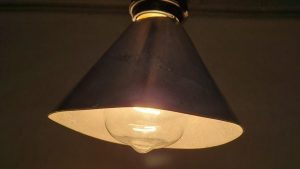Could indoor air pollution have met its match? Researchers have announced the creation of innovative catalyst-coated lampshades that act as indoor air purifiers.
These indoor air purifiers work to transform harmful pollution into harmless compounds, destroying indoor air pollution.
The lampshades work with halogen and incandescent light bulbs, and the team is extending the technology to be compatible with LEDs.
The researchers will present their results during Autumn’s American Chemical Society (ACS) meeting.
A new way of removing harmful air pollution
The indoor air purifiers target volatile organic compounds (VOCs), which account for most indoor airborne pollutants, according to Hyoung-il Kim, PhD, the project’s principal investigator.
These compounds include acetaldehyde and formaldehyde and are released by paints, cleaners, air fresheners, plastics, furniture, cooking, and other sources.
Kim explained: “Although the concentration of VOCs in a home or office is low, people spend more than 90% of their time indoors, so the exposure increases over time.
“Conventional methods to remove VOCs from indoor air rely on activated carbon or other types of filters, which have to be replaced periodically,” added Minhyung Lee, a graduate student in Kim’s lab at Yonsei University.
Other indoor air purifiers have been developed that break down VOCs with the help of thermocatalysts activated by high temperatures or with photocatalysts, which respond to light.
However, the majority of these need a separate heater or an ultraviolet (UV) light source, which can produce unwanted byproducts.
Therefore, the researchers wanted a more straightforward approach requiring only a visible light source producing heat and a lampshade coated with a thermocatalyst.

How does the new indoor air purifier work?
Halogen bulbs only convert 10% of the power they use into light, with the other 90% being transformed into heat, according to Lee. Incandescent bulbs are even worse, emitting 5% light and 95% heat.
“This heat is typically wasted, but we decided to use it to activate a thermocatalyst in the indoor air purifier that decomposes VOCs,” said Kim.
In a paper published last year, the team reported synthesising thermocatalysts made of titanium dioxide and a small amount of platinum.
The researchers coated the inside of an aluminium lampshade with the catalyst and placed the shade over a 100-watt halogen bulb in a test chamber containing air and acetaldehyde gas.
Turning the lamp on heated the shade to about 250°F – warm enough to activate the catalysts and decompose acetaldehyde. During this oxidation process, the indoor air purifier converted VOC into acetic acid, formic acid, carbon dioxide, and water.
Both acids are mild, and the amount of carbon dioxide released was harmless. Moreover, the researchers also discovered that formaldehyde can be decomposed under the same conditions and that the technique works with incandescent bulbs.
Future uses of the research
In their latest work, the researchers turned to less expensive substitutes for platinum. The team has already shown that these new iron- or copper-based indoor air purifiers can break down VOCs.
They are now looking for ways to extend the pollution-destroying lampshade concept to LEDs, a fast-growing segment of the lighting market. However, unlike halogen and incandescent bulbs, LEDs release too little heat to activate thermocatalysts.
Therefore, the team is developing photocatalysts that are stimulated by the near-UV light emitted by LEDs and other catalysts that transform part of the LEDs’ visible light output into heat.
Kim concluded: “Our ultimate goal is to develop a hybrid catalyst that can utilise the full spectrum produced by light sources, including UV and visible light, as well as waste heat.”









